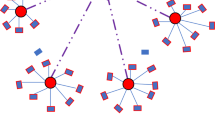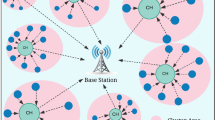Abstract
In this paper, we propose a multilevel heterogeneous network model characterized by a parameter, called model parameter that helps the model defining a network of 0-level, 1-level, 2-level, 3-level, and 4-level heterogeneity. We consider the hybrid energy efficient distributed (HEED) clustering protocol to estimate the network lifetime and accordingly name it as HEEDML (HEED MultiLevel). Depending on the heterogeneity, its variants have been named as HEEDML-0, HEEDML-1, HEEDML-2, HEEDML-3, and HEEDML-4 for 0-level, 1-level, 2-level, 3-level, and 4-level heterogeneity. The HEEDML-0 is the original HEED. The model parameter also determines the numbers of nodes of each type. We use the same parameters as in the HEED to decide the cluster heads: residual energy and node density. We also consider fuzzy implementation of the HEEDML. The HEEDML-1, HEEDML-2 HEEDML-3, and HEEDML-4 increase network lifetime by 39.61, 117.38, 182.69, and 223.7 %, corresponding to the increase in the network energy as 9.2, 17.40, 21.80, and 24 %, with respect to the HEEDML-0. The fuzzy implementation further increases the network lifetime. The HEEDML-FL-0, HEEDML-FL-1, HEEDML-FL-2, HEEDML-FL-3, and HEEDML-FL-4 increase the network lifetime by 193.84, 270.31, 375.84, 448.33, and 589.07 %, corresponding to the same increase in network energy as that for HEEDML (all levels) with respect to that of the HEEDML-0. The HEEDML-FL-0 increases the network lifetime by 193.84 % with respect to the original HEED without increasing the network energy. The packet delivery, total energy consumption, throughput, average delay, and traffic load have better results.










Similar content being viewed by others
References
Akyildiz, I. F., Su, W., Sankarasubramaniam, Y., & Cayirci, E. (2002). WSNs: A survey. Computer Networks, 38, 393–422.
Ullah, M., & Ahmad, W. (2009) Evaluation of routing protocols in WSNs. Master Thesis, Department of Interaction and System Design, School of Engineering at Blekinge Institute of Technology.
Lewis, F. L. (2004). WSN. New York: Technologies Protocols and Applications.
Khetrapal, A. (2006) Routing techniques for mobile ad hoc networks classification and qualitative/quantitative analysis. In Proceedings international conference on wireless networks, (ICWN 2006) (pp 251–257).
Younis, O., & Fahmy, S. (2004). HEED: A hybrid, energy efficient, distributed clustering approach for ad hoc sensor networks. IEEE Transactions on Mobile Computing, 3(4), 366–379.
Frikha, M., & Slimane, J. B. (2006) Conception and simulation of energy efficient AODV protocol ad hoc networks. In 3rd International conferenc on mobile technology, applications and systems (pp. 1–7).
Heinzelman, W. R., et al. (2000) Energy scalable algorithms and protocols for wireless microsensor networks. In Proceedings of the international conference on acoustics, speech, and signal processing (ICASSP ‘00), Istanbul, Turkey.
Manjeshwar, A., & Agarwal, D. P. (2001) TEEN: A routing protocol for enhanced efficiency in WSNs. In 1st International workshop on parallel and distributed computing issues in wireless networks and mobile computing, April 2001.
Manjeshwar, A., & Agarwal, D. P. (2001) APTEEN: A hybrid protocol for efficient routing and comprehensive information retrieval in WSNs. In Parallel and distributed processing symposium, IPDPS 2002 (pp. 195–202).
Akkaya, K., & Younis, M. (2005). A survey on routing protocols for WSNs. Ad Hoc Networks, 3, 325–349.
Heinzelman, W. R., Chandrakasan, A. P., & Balakrishnan, H. (2000) Energy-efficient communication protocol for wireless microsensor networks. In Proceedings of the 33rd Hawaii international conference on system sciences (HICSS-33).
Heinzelman, W. R., Chandrakasan, A. P., & Balakrishnan, H. (2002). An application specific protocol architecture for wireless microsensor networks. IEEE Transactions on Wireless Communications, 1(4), 660–670.
Lindsey, S., & Raghavendra, C. S. (2002) PEGASIS: Power efficient gathering in sensor information systems. In Proceedings of the IEEE aerospace conference, Big Sky, Montana, March 2002.
Lindsey, S., Raghavendra, C. S., & Sivalingam, K. (2001) Data gathering in sensor networks using the energy*delay metric. In Proceedings of the IPDPS workshop on issues in wireless networks and mobile computing, San Francisco, CA.
Smaragdakis, G., Matta, I., & Bestavros, A. (2004) SEP: A stable election protocol for clustered heterogeneous WSNs. In Second international workshop on sensor and actor network protocols and applications (SANPA 2004).
Kumar, D., Aseri, T. C., & Patel, R. B. (2009). EEHC: Energy efficient heterogeneous clustered scheme for WSNs. Computer Communications, 32, 662–667.
Mao, Y., Liu, Z., Zhang, L., & Li, X. (2009) An effective data gathering scheme in heterogeneous energy wireless sensor networks. In Proceedings of international conference on computational science and engineering (pp. 338–343).
Qing, L., Zhu, Q., & Wang, M. (2006). Design of a distributed energy efficient clustering algorithm for heterogeneous WSNs. Computer Communications, 29, 2230–2237.
Haibo, Z., Yuanming, W., & Guangzhong, X. (2009) EDFM: A stable election protocol based on energy dissipation forecast method for clustered heterogeneous WSNs. In Proceedings of the 5th international conference on wireless communications, networking and mobile computing (pp. 3544–3547).
Elbhiri, B., Rachid, S., Zamora, A.-P., & Aboutajdine, D. (2009). Stochastic distributed energy-efficient clustering (SDEEC) for heterogeneous WSNs. ICGST-CNIR Journal, 9(2), 11–17.
Kumar, D., Patel, R., & Aseri, T. C. (2010). Prolonging network lifetime and data accumulation in heterogeneous sensor networks. International Arab Journal of Information Technology, 7(3), 302–309.
Kumar, D., Aseri, T. C., & Patel, R. B. (2011). EECDA: Energy efficient clustering and data aggregation protocol for heterogeneous wireless sensor networks. International Journal of Computers Communications & Control, 6(1), 113–124.
Kumar, D. (2012). Distributed stable cluster head election (DSCHE) protocol for heterogeneous wireless sensor networks. International Journal of Information Technology, Communications and Convergence, 2(1), 90–103.
Mantri, D., Prasad, N. R., & Prasad, R. (2013) BHCDA: Bandwidth efficient heterogeneity aware cluster based data aggregation for wireless sensor network. In International conference on advances in computing, communications and informatics (ICACCI) (pp. 1064–1069).
Qureshi, T. N., et al. (2013) BEENISH: Balanced energy efficient network integrated super heterogeneous protocol for wireless sensor networks. In International workshop on body area sensor networks (BASNet-2013), Procedia Computer Science (pp. 1–6).
Chand, S., Singh, S., & Kumar, B. (2014). Heterogeneous HEED protocol for wireless sensor networks. Wireless Personal Communications, 77(3), 2117–2139.
Singh, S., Chand, S., Kumar, R., & Kumar, B. (2013) A heterogeneous network model for prolonging lifetime in 3-D WSNs. IEEE/IET. In 4th International conference CONFLUENCE 2013: The next generation information technology summit, 26th–27th Sept. 2013 (pp. 257–262).
Chand, S., Singh, S., & Kumar, B. (2013). hetADEEPS: ADEEPS for heterogeneous wireless sensor networks. International Journal of Future Generation Communication and Networking, 6(5), 21–32.
Chand, S., Singh, S., & Kumar, B. (2013). 3-Level heterogeneity model for wireless sensor networks. International Journal of Computer Network and Information Security (IJCNIS), 5(4), 40–47.
Taheri, H., Neamatollahi, P., Younis, O. M., Naghibzadeh, S., & Yaghmaee, M. H. (2012). An energy-aware distributed clustering protocol in wireless sensor networks using fuzzy logic. Ad Hoc Networks, 10(7), 1469–1481.
Author information
Authors and Affiliations
Corresponding author
Rights and permissions
About this article
Cite this article
Singh, S., Chand, S. & Kumar, B. Energy Efficient Clustering Protocol Using Fuzzy Logic for Heterogeneous WSNs. Wireless Pers Commun 86, 451–475 (2016). https://doi.org/10.1007/s11277-015-2939-4
Published:
Issue Date:
DOI: https://doi.org/10.1007/s11277-015-2939-4




